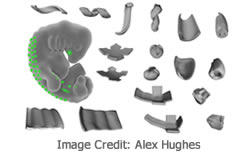Recent News & Events
Engineering 3D Tissue - Controlling Complex Shapes In Vitro
08
 As tissues develop, they fold, coil and ripple into complex shapes. Researchers could make great advances in tissue engineering if they can control the shapes in vitro. After discovering more parallels between biology and technology, bioengineers at the University of California, San Francisco, found a relatively simple way to do just that. They can develop predetermined three-dimensional tissues by programming active mouse and human cells to extracellular matrix fibers.
As tissues develop, they fold, coil and ripple into complex shapes. Researchers could make great advances in tissue engineering if they can control the shapes in vitro. After discovering more parallels between biology and technology, bioengineers at the University of California, San Francisco, found a relatively simple way to do just that. They can develop predetermined three-dimensional tissues by programming active mouse and human cells to extracellular matrix fibers.
The New Way to Engineer 3-D Tissue
To engineer the 3-D tissue, a lab team at the Center for Cellular Construction at UCSF used mesenchymal stem cells, which bind other cells together just like mortar binds together bricks. While studying the digestive tracts of mice, they could see the cells push and pull collagen into shapes that eventually developed into minute projections in the intestines that aid nutrient absorption.
The researchers put mesenchymal cells from humans and mice onto 1-centimeter-long collagen fibers. The cells mechanically worked together through the fibers to fold in predictable ways that mimic the natural development process. The scientists observed the fibers warping into shapes over a couple of hours, reports senior author Zev Gartner
The lab team also learned how to predict the shapes that would develop based on where they were placed on the collagen as well as other factors. After testing other cells on the collagen, they discovered that they could construct new shapes under certain circumstances. Additionally, they introduced challenges and errors to prevent the stem cells from changing the collagen. However, they often failed, which suggests that those elements are strong enough for future engineering.
How Programming Cells Differs From Current Techniques
For years, scientists have been pursuing the idea of building bio-compatible machines with living cells. Labs currently use micro-molding or 3-D printing to create shapes for tissue engineering. However, these techniques restrict tissue growth or require laying down the tissue piece by piece. The final product doesn't retain the key structural features that grow in tissues during natural development.
The new technique allows the cells to grow more normally while using DNA-programmed assembly of cells to guide the growth. The DPAC basically creates a template that makes the cells naturally organize in a different way. The result is layers of tissue that fold and curve to create complex shapes.
UCSF Postdoctoral Fellow Alex Hughes, the first author of the study, says that they're starting to see how natural developmental processes can be broken down into engineering principles that will allow them to understand and build tissues. Their new technique gives them an all new angle on engineering tissue.
What This Discovery Means for Biotechnology
Gartner believes that their work can improve how biologists create organoids. These lab-grown tissues and organs have become very popular tools for precision medicine. They allow scientists to test the effectiveness of drugs against a person's disease before administering the drugs. However, the current process for creating organoids requires cloning an organism and harvesting the organs.
The new technique simplifies the process a great deal. Along with improving drug effectiveness testing, it could allow researchers to improve transplant treatments. It may also improve research into cures for diseases and why abnormal tissue growth happens.
